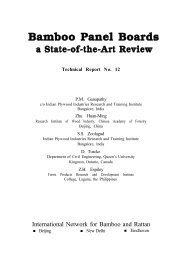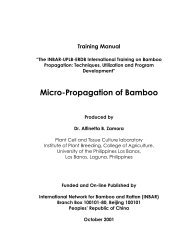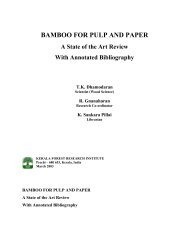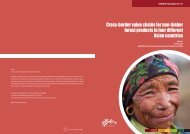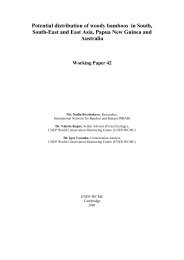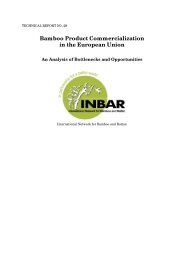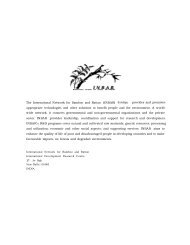The Bamboo and Rattan Sectors in Asia: an Analysis of ... - INBAR
The Bamboo and Rattan Sectors in Asia: an Analysis of ... - INBAR
The Bamboo and Rattan Sectors in Asia: an Analysis of ... - INBAR
Create successful ePaper yourself
Turn your PDF publications into a flip-book with our unique Google optimized e-Paper software.
Constra<strong>in</strong>ts <strong><strong>an</strong>d</strong> opportunities<br />
<strong>The</strong>re is grow<strong>in</strong>g dem<strong><strong>an</strong>d</strong> for Laoti<strong>an</strong> ratt<strong>an</strong> products <strong>in</strong> the domestic <strong><strong>an</strong>d</strong><br />
<strong>in</strong>ternational markets, especially <strong>in</strong> Vietnam. More ratt<strong>an</strong> furniture factories are com<strong>in</strong>g<br />
on stream, <strong><strong>an</strong>d</strong> those that are established are gett<strong>in</strong>g better <strong><strong>an</strong>d</strong> are look<strong>in</strong>g for outlets<br />
for their product. <strong>The</strong>re are no estimates <strong>of</strong> the amount <strong>of</strong> ratt<strong>an</strong> that is available or<br />
<strong>of</strong> the productivity <strong>of</strong> natural ratt<strong>an</strong> <strong>in</strong> the country. Thus, there is some d<strong>an</strong>ger <strong>of</strong><br />
early commercial overexploitation, assuaged somewhat by the fact that access to the<br />
forested areas is relatively poor. Although it is currently a relatively small sector,<br />
ratt<strong>an</strong> collection provides a critically import<strong>an</strong>t source <strong>of</strong> cash <strong><strong>an</strong>d</strong> food for m<strong>an</strong>y<br />
ratt<strong>an</strong> collectors. <strong>Ratt<strong>an</strong></strong> process<strong>in</strong>g provides jobs, <strong>in</strong>come <strong><strong>an</strong>d</strong> some badly needed<br />
foreign exch<strong>an</strong>ge earn<strong>in</strong>gs. It is especially import<strong>an</strong>t for forest-marg<strong>in</strong> people who<br />
have very limited alternatives.<br />
Clearly, there is a need for basic <strong>in</strong>ventory data to determ<strong>in</strong>e how much ratt<strong>an</strong><br />
is available <strong><strong>an</strong>d</strong> to estimate susta<strong>in</strong>able harvest levels. If it is true that the resource<br />
is be<strong>in</strong>g harvested unsusta<strong>in</strong>ably, there is a need for ch<strong>an</strong>ges <strong>in</strong> the m<strong>an</strong>agement<br />
strategy.<br />
<strong>The</strong>re may be scope for <strong>in</strong>creas<strong>in</strong>g ratt<strong>an</strong> production <strong>in</strong> the forest through<br />
enrichment pl<strong>an</strong>t<strong>in</strong>g with either local or exotic species. It would be especially useful<br />
to pl<strong>an</strong>t cluster<strong>in</strong>g, large-diameter species that lend themselves to multiple harvests.<br />
Current research on underst<strong><strong>an</strong>d</strong><strong>in</strong>g the taxonomy <strong>of</strong> the resource base will facilitate<br />
such decisions.<br />
However, technical <strong>in</strong>terventions are unlikely to be very successful without<br />
reform <strong>in</strong> the resource ownership. Under the current system the ratt<strong>an</strong> resource<br />
is owned by the state <strong><strong>an</strong>d</strong> sold on a concession basis to furniture m<strong>an</strong>ufacturers.<br />
<strong>The</strong> short tenure (1 year) discourages <strong>an</strong>y effort to repl<strong>an</strong>t or encourage re-growth.<br />
More import<strong>an</strong>tly, the ratt<strong>an</strong> cutters are engaged only as hired labor. <strong>The</strong> resource<br />
is treated as <strong>an</strong> open access resource. <strong>The</strong>y have neither <strong>in</strong>centive nor expertise<br />
to m<strong>an</strong>age the resource susta<strong>in</strong>ably. <strong>The</strong> only limit on accelerated exploitation <strong>of</strong><br />
the resource is that access to the ratt<strong>an</strong> areas is limited <strong><strong>an</strong>d</strong> there is limited<br />
number <strong>of</strong> buyers.<br />
An alternative system giv<strong>in</strong>g resource control, along with some technical<br />
assist<strong>an</strong>ce (tra<strong>in</strong><strong>in</strong>g <strong>in</strong> enrichment pl<strong>an</strong>t<strong>in</strong>g <strong><strong>an</strong>d</strong> m<strong>an</strong>agement techniques; improved<br />
pl<strong>an</strong>t<strong>in</strong>g material; post-harvest preservation technology) to the cutters could encourage<br />
<strong>in</strong>creased productivity <strong><strong>an</strong>d</strong> provide a valuable avenue for improv<strong>in</strong>g the welfare <strong>of</strong><br />
this disadv<strong>an</strong>taged group. <strong>The</strong> new Forest Law (1996) is progressive <strong>in</strong> terms <strong>of</strong><br />
encourag<strong>in</strong>g community forest m<strong>an</strong>agement.<br />
Technical improvements along with improved market<strong>in</strong>g <strong>in</strong> the process<strong>in</strong>g<br />
<strong>in</strong>dustry could <strong>in</strong>crease the value <strong>of</strong> the f<strong>in</strong>ished products. This could <strong>in</strong> turn<br />
stimulate <strong>in</strong>creased raw material prices, <strong><strong>an</strong>d</strong> <strong>in</strong>creased <strong>in</strong>centives for susta<strong>in</strong>able<br />
m<strong>an</strong>agement.<br />
44



